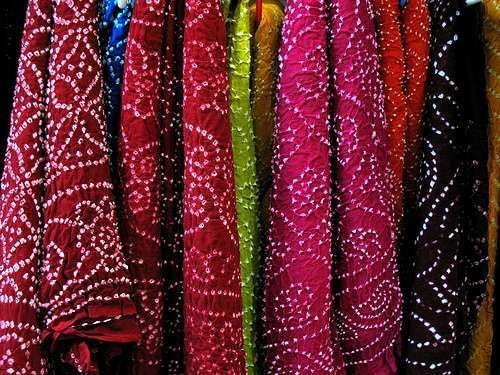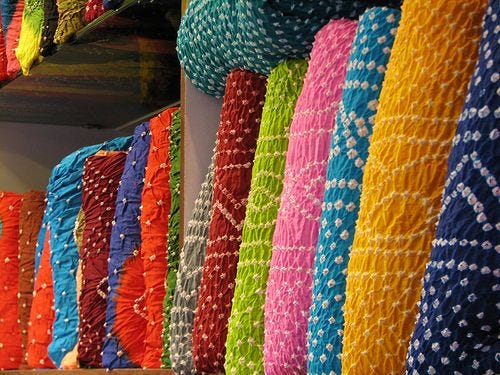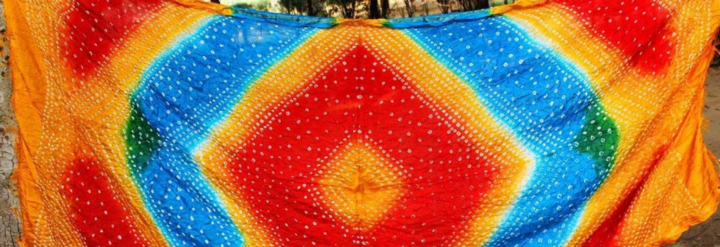Bandhni is one of the oldest techniques used to dye and create colourful, patterned textiles. Bandhni- which derives from the Hindi word bandhan and literally translates to tye- involves pinching the cloth and tying the fabric into many different bindings, and which is then dyed in different colour combinations. Once dyed, the fabric is air dried and then unraveled to reveal beautiful patterns like Chandrakala, Shikari and Bavan Baug etc. Usually performed on cotton or silk fabric, the technique can be traced back to the Indus Valley Civilization in as early as 4000 BC, where dyeing was done using bright naturally derived colours like red, yellow, blue, green and black. These colours were commonly derived from natural items like rusted iron pieces, kesuda flowers, pomegranate peels, dried mango powder, lime juice, and alum. Later evidence of bandhani cloth has also been found in the cave paintings of Ajanta. Today, it is commonly believed that the technique was developed in the Sindh region and spread throughout the subcontinent from there.


Bandhni is only carried out by skilled craftsmen because of the specificity of the technique, because of which it has remained indigenous to places like Gujarat, Rajasthan, and a few regions of Uttar Pradesh. In Gujarat, it is traditionally done by the Khatri community from the Kutchh and Saurashtra region, and the most commonly found Bandhni designs there include an abundant use of dots and different hues. The bandhni designs emerging from the Rajasthan region are commonly known as lahariya, and all of them commonly involve an abundant display of wavy and stripy patterns as opposed to dots. In addition to the patterns, even the colours used came to obtain a significance over time. For instance, in Gujarat, the red colour came to be identified as a symbol of marriage and therefore, red bandhani was commonly worn by newly-wed brides. Similarly, yellow meant the arrival of spring, and black came to be associated with mourning. Depending on the region of origin, the design and the pattern of the bandhani cloth varies, and that is only possible because the cloth is tied and dyed by hand, instead of a machine.
Due to its exquisite craftsmanship as well as the possibility of customizations, the bandhni has, in recent years, seen a rise in its popularity. In addition to bandhani sarees and odhnis, it has also become a fabric of choice for women’s suits, dresses, and kameezes. It has also become popular among men who use the fabric in turbans and to accessorize their kurtas, which helps add some excitement to their wardrobe. Embellishing the textile with gota or mirror work has also become common, which adds some majesty, elegance, and spark to the fabric and makes it more attractive. This upsurge in the popularity of the fabric has been quite significant because this has made possible the revival of an ancient, age-old technique that was on the verge of being forgotten in this age of industrial manufacturing. Furthermore, this has also allowed the retention of employment for many communities who have been practitioners of this old Indian technique for generations, and who produced such skilled and expert artisans.
